Excerpts from Jim Conrad's
Naturalist Newsletter
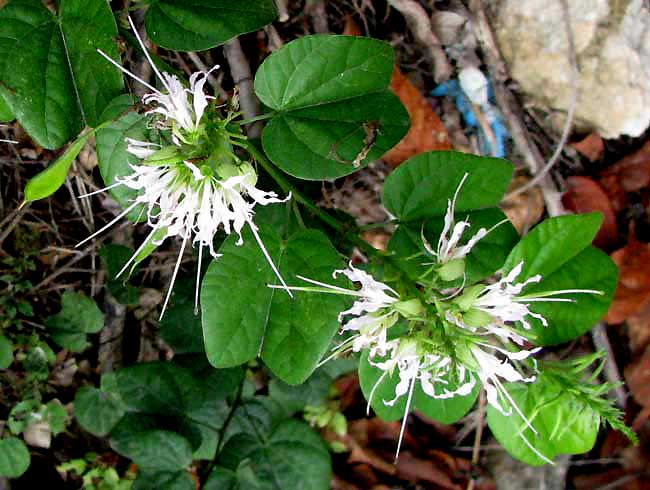
from the February 13, 2011 Newsletter issued from Hacienda Chichen Resort beside Chichén Itzá Ruins, central Yucatán, MÉXICO; limestone bedrock, elevation ~39m (~128ft), ~N20.676°, ~W88.569°
COWFOOT
Above you see an easy-to-recognize shrub or small tree that appears commonly along forest trails and woods edges, even sometimes in very disturbed habitats, almost like a weed. It's distributed all through tropical lowland Mexico, the Caribbean and Central America to Costa Rica, so if you travel in this region here's a good species to recognize. Notice the leaves' distinctive shape, like the hoof of a cow. In Spanish the bush is called Pata de Vaca, or Cowfoot. It's BAUHINIA DIVARICATA, and some of its flowers are shown close-up below:
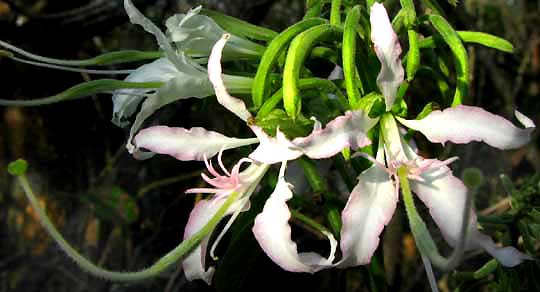
In tropical America whenever you see a shrub or tree with cow-hoof-shaped leaves, it's usually the genus Bauhinia of the Bean Family. Most Bean Family species have compound leaves, so such "simple" leaves are a little unusual for that family, and to have that shallow indentation at the tip of the leaf is really distinctive. Also one somewhat odd feature of this species is that each flower bears just a single fertile stamen, though other much reduced, sterile ones manifest themselves as a kind of showy fringe in the flower's center. In the picture, the very long, upward curving items with green bulges in their centers are pistils, the green part being the ovary and future legume, the slender white part being the style, and the green, round tip the stigma. New flowers are white but as they age they develop a pinkish tinge.
We've encountered other Bauhinia species before. You might enjoy seeing how the same basic structure expresses itself so differently in other species -- see "variations on the Bauhinia theme." Check out the Purple Orchid Tree we saw back in Querétaro at www.backyardnature.net/mexnat/bauhin-1.htm.
Also there was one in Chiapas we couldn't name, shown at www.backyardnature.net/chiapas/cowfoot.htm.
An infusion of this Bauhinia's flowers sometimes is made into a remedy for bronchitis.
from the May 24, 2018 Newsletter issued from Rancho Regenesis in the woods ±4kms west of Ek Balam Ruins; elevation ~40m (~130 ft), N~20.876°, W~88.170°, central Yucatán, MÉXICO
COWFOOT FRUITS
Nowadays Cowfoot is bearing legume-type fruits, as shown below:
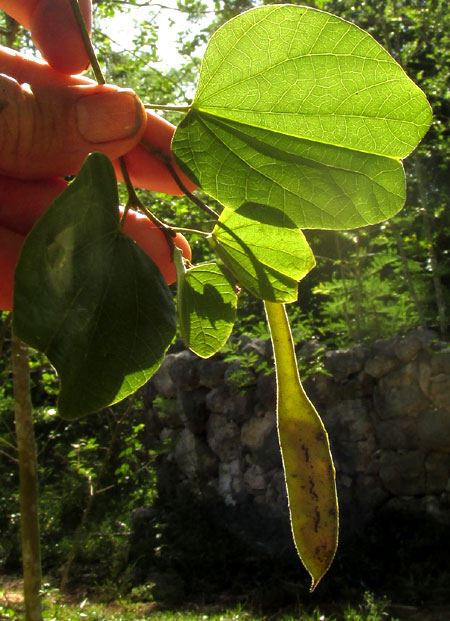
These legumes are unusual because their few beans are restricted to the fruit's lower half, giving the fruit something of a meat-cleaver shape.
from the March 15, 2019 Newsletter issued from Rancho Regensis north of Valladolid, Yucatán, MÉXICO;
elevation ~40m (~130 ft), N~20.876°, W~88.170°
COWFOOT WITH A DIFFERENT LOOK
Along the narrow entry road into the village of Ek Balam the slender, dry-season-leafless branches of small tree only about 3m tall (10ft) bore a compact cluster of white flowers at their very tips, as shown at below:
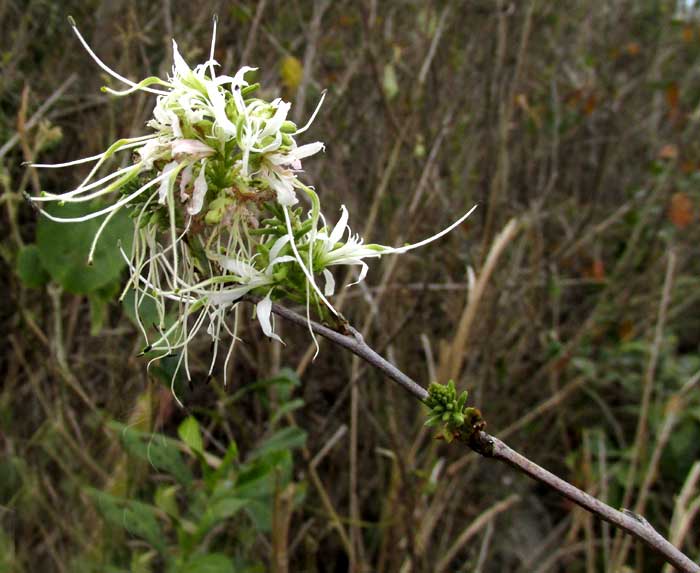
The flowers were very similar, maybe identical, to those on the cowfoot documented above, However, above you can see that the species' attractive blossoms cluster in bunches along leafy stems, the leaves shaped like the prints of cow hooves. They're just not "supposed" to bunch together like this at the tip of leafless branches. However, up close, the flowers still looked like those of our common Cowfoot, shown below:
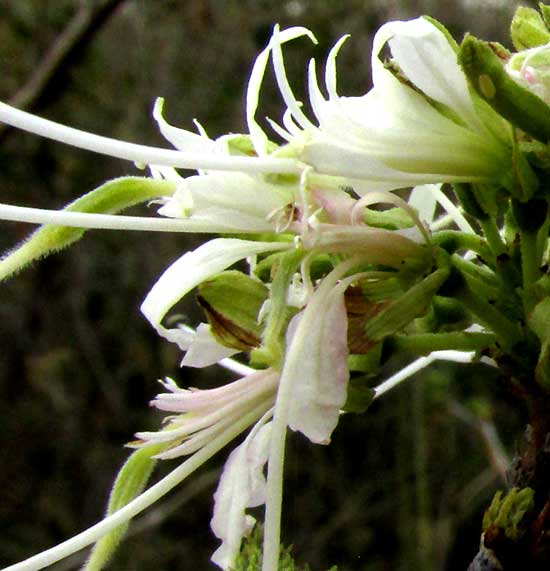
Could this be another of the Yucatan Peninsula's six cowfoot species? No. None of the other five species' flowers look like these. Apparently during the dry season our common cowfoot species is simply capable of clumping its flowers at the end of leafless branches like this.
Probably this adaptability and flexibility is what enables Bauhinia divaricata to be our most common cowfoot species, almost weedy in nature despite its handsome flowers.
from the March 10, 2008 Newsletter written in the community of 28 de Junio, in the Central Valley 8 kms west of Pujiltic, elev. ~700m (2300ft), ~N16.331°, ~W92.472°; southeastern Chiapas state, MÉXICO
COWFOOTS FLOWERING
A common, pretty bush flowering nowadays in disturbed areas is a Bean Family member belonging to a genus whose members are often known in Spanish as Pata de Vacas, or cowfoots. The cowfoot genus is BAUHINIA. You'll understand where the cowfoot name comes from when the see the roundish, cleft leaves shown below:
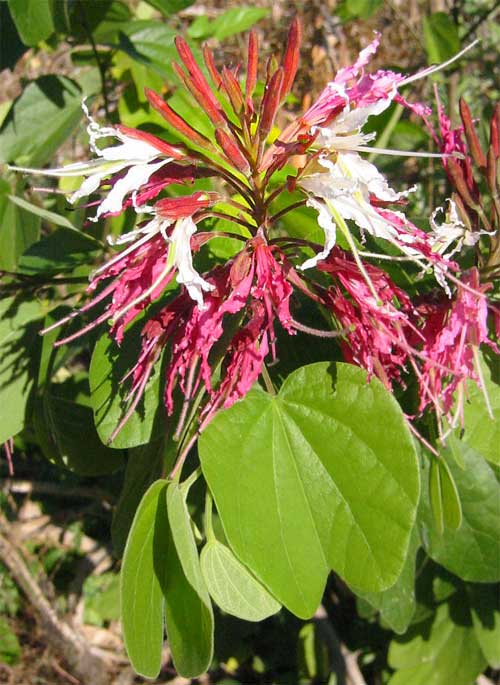
I'm always tickled to see those cowfoot-shaped leaves because they announce the genus Bauhinia with such certainty. I know of no other group of plants with such a leaf shape. Breedlove's Flora of Chiapas lists over 600 species belonging to the Bean Family, the vast majority producing compound, sometimes twice- or thrice-compound, often look-alike leaves, but only the twelve Bauhinia species listed for Chiapas have those cowfoot leaves.
Bauhinia's pretty flowers are a little reminiscent of the North's unrelated honeysuckles. For one thing, the newly opened, not-yet-pollinated flowers are white, but once they've been pollinated they quickly turn reddish. When honeysuckle blossoms are pollinated they turn yellow. In both cases, the already-pollinated flowers are less bright than the white ones, thus helping focus the attention of pollinating insects on blossoms still needing to be visited.
This Bauhinia species is a vigorous, aggressive weed here. It grows so fast that it turns up in cornfields head-high and flowering after being established there only since the last planting season. Sometimes downslope from a mother tree you see dozens of younger plants forming a thicket, where a relatively high percentage of the parent's seeds have germinated.
One gets a feeling that if the Earth undergoes the catastrophic environmental collapse many foresee because of global warming, this tough little Bauhinia species might be one of a few species surviving, and for that sake alone I'm glad it has such pretty flowers. The people who come after us are going to need all the loveliness in their lives they can get.